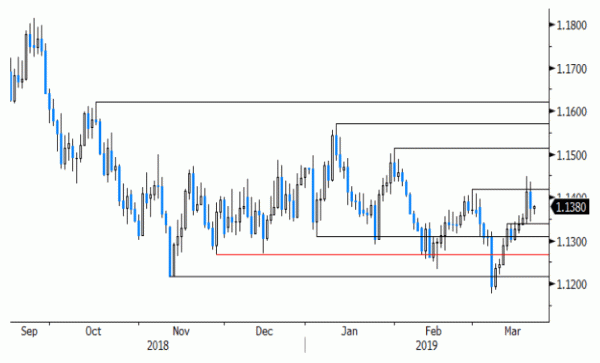- Rates: First test of key 2.5% support in US 10-yr yield
The US 10-yr yield bounced off the key 2.5% support area yesterday, but we label the test as ongoing following the Fed’s dovish turn. Today’s eco calendar contains EMU PMI. We see upside risks vs consensus, but fear an asymmetric market reaction: core bond gains in case of disappointment against inaction in case of a positive surprise. - Currencies: dollar sell-off halted. Will better EMU PMI’s support the euro?
USD trading was driven by conflicting factors yesterday. In the end, the US currency regained part of its post-Fed loss. Today, the EMU PMI’s might determine daily sentiment for EUR/USD trading. However, we don’t expect the pair to break out of established ranges, whatever the outcome. Sterling suffers as Brexit uncertainty intensifies
The Sunrise Headlines
- US stocks roared yesterday with the tech heavy Nasdaq outperforming (1.42%). Asian markets are trading mixed. China staged a strong intraday comeback but remains the region’s laggard (-0.4%)
- The US imposed the first new North Korea sanctions since the failed summit last month. They said to have identified two Chinese companies helping North Korea to evade current economic sanctions and froze any US assets they have.
- If PM May gets her deal approved next week, EU leaders are willing to let the UK remain in the bloc until May 22 to wrap up formalities. If she can’t pull it off, May has until April 12 to leave with no deal or request a much longer extension.
- Japanese February inflation disappointed. Headline data stabilized at 0.2% YoY vs. 0.3% expected. Core measures ex. food (and energy) showed a 0.7% (0.4%) rate vs. 0.8% (0.4%) expected. March’s manufacturing PMI stabilized at 48.9.
- Trump recognized the Golan Heights as Israeli territory after the country annexed the area in 1981, a move not recognised internationally. The move is seen as a bid to support Israeli president Netanyahu’s re-election next month.
- The White House rejected a congressional Democrats’ request for information about Trump’s communications with his Russian counterpart Putin in an investigation of possible obstruction of justice or abuse of power.
- Today’s economic calendar contains US’s existing home sales and Canadian inflation data. Markets will also watch for EMU PMI’s to show signs of bottoming out in line with other recent data
Currencies: Dollar Sell-Off Halted. Will Better EMU PMI’s Support The Euro?
Will better PMI’s support EUR/USD further?
FX markets weighed the consequences of Wednesday’s Fed communication yesterday. The dollar won’t receive Fed interest rate support in the foreseeable future, but that is also the case for the euro. The picture for USD (EUR/USD) trading was a bit puzzling. The US currency gradually fought back on Wednesday’s sell-off. This rebound occurred even as US yields remained well below the pre-Fed levels. At the same time, US equities rebounded which is usually also no USD supportive. US data were mixed, at best. Still, at some point, EUR/USD completely erased the post-Fed rebound. The pair closed at 1.1374 (1.1413 Wednesday). The intraday rebound of the dollar against the yen was more modest. The pair closed at 110.82 (from 110.70).
This morning, Asian markets show a mixed picture. Japan inflation (0.2% Y/Y headline, 0.4% ex fresh food) is drifting ever further away from the BoJ inflation target. The Japan 10-j yield (-0.07%) is touching the lowest levels since end 2016. Still, the impact on the yen is limited (USD/.JPY 110.75 area). EUR/USD also stabilizes in the 1.1380 area.
Today’s EMU PMI’s are interesting. Markets will look out for signs of improvement, confirming the hypothesis that the slowdown at the end of 2018/early this year might be temporary. A single positive surprise won’t change expectations on the ECB interest rate trajectory. Still, a surprise in either direction might guide the intraday euro sentiment. We see a slightly higher chance for positive surprise. If so, it might help EUR/USD to return north of 1.14, but we don’t expect a breach of important technical levels. This week’s soft Fed communication evidently was USD negative and helps to put a floor for EUR/USD. That said, in a broader perspective, the Fed and the ECB are now a similar soft, wait-and-see modus. The euro had already a good run. In this respect, a sustained break beyond the 1.1514 resistance is not evident. Such a test/break probably needs US data to deteriorate further. We assume it’s too early for that.
The BoE kept a cautious positive assessment on the economy yesterday. Markets evidently didn’t react as the BoE’s view is conditional on an orderly Brexit. The latter looks ever further away. At the EU summit, EU leaders gave UK PM May until April 12 to decided what to do if she doesn’t get the deal approved in Parliament. EUR/GBP briefly jumped above 0.87 yesterday evening. With visibility on the Brexit process becoming foggier rather than clearer, the era of erratic sterling trading also risks to be prolonged for another two weeks
EUR/USD: holding firmly within the 1.12/1.16 range. Will better EMU PMI’s provide some additional support













